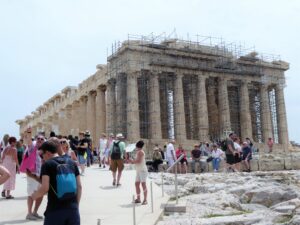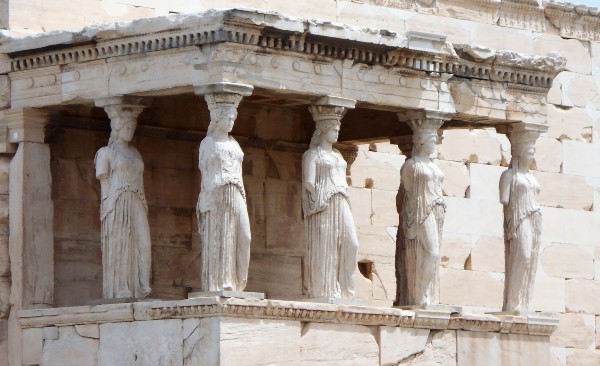
by Ellen Shubart, Class or 2006|
Photographs by Richard W. Shubart
Greece has been hardwired into many of us since we were kids. In elementary school we learned about Greek gods and their myths, and in English lit classes we found those same gods playing roles in Shakespeare’s plays and contemporary novels. And the Aegean Sea and Santorini are touted as some of the most beautiful sites in the world.
Husband Richard and I had always wanted to visit Greece and first satisfied that urge in 1964. But it took until last spring to get back and really see Greece.
On a three-week vacation, we spent a week on the island of Crete (CLICK HERE to read Emily Clott’s Greece story in the archived articles on The Bridge). And on the mainland, we visited Athens, Meteora with its Greek Orthodox churches set amidst spectacular rock formations, (inspiring the word “meteor” in English), and Delphi, the home of the famed Greek Oracle. Finally, we spent seven days on a small (50+ person) ship cruising among eight islands. We ended in Turkey, visiting Ephesus and Istanbul.
Highlights of the trip were many. Greek salads – tomatoes, onions, cucumbers, and feta cheese in an olive oil dressing – first among them followed by raki and retsina, wines from local grapes. Greece is one of Europe’s most mountainous countries, requiring lots of walking on uneven terrain. The country’s popularity brings tourists and giant cruise ships to many harbors, but our boat’s small size meant we saw more of the smaller islands– and we swam in the Aegean!
But the overwhelming emphasis for us was archeology. Here are a few of the sites we enjoyed the most:
The Acropolis: The Parthenon, Museum. When we were in Greece so long ago, it was possible to hike up to the Parthenon and walk through the temple. That option is long gone, and today the hike is a trek you take with hundreds of newfound “friends.” It is crowded, overcrowded perhaps, and the Parthenon itself is scaffolded all around. Yet it is the symbol of the country, and when it is lighted up at night shines brightly from atop the Acropolis. The excellent Acropolis Museum, designed by Swiss architect Bernard Tschumi and Greece’s Michalis Fotiadis (2009) at the foot of the hill is remarkable, designed so the top of the Parthenon and the top floor of the museum have identical measurements. If, or when, the Elgin/Parthenon (as the Greeks call them) Marbles return from London, spaces are ready to receive them. Until then, other frieze pieces and photos fill the space.



The Hephaestion. The Agora was Athens’ commercial center from the 1st century BC to 4th century AD. Looming over the Agora is the Hephaistion, the best preserved ancient Greek temple in the world. It is a similar, smaller version of the Parthenon and has all its columns intact.

The Palace of Knossos, Crete: The largest site for Minoan culture (2700 to 1450 BC), these ruins of the palace of King Minos date from about 1900 BC. Discovered in 1878, the palace is comprised of a maze of apartments, workrooms, and courtyards. Many have replica frescoes showing life in the Bronze Age. The nearby Heraklion Archeological Museum features the original frescoes and figurines, ceramics, and jewelry from the site.

Ancient Akrotiri, Santorini: A huge, well-preserved late-Neolithic complex buried after a volcanic eruption in Minoan times. The site is reminisent of Pompeii, Italy, but the Greeks knew an eruption was coming and left, so no bodies were buried. The site has a protective roof spanning the entire enclosed area, a huge city. Workers in the 1860s quarrying volcanic ash rediscovered the settlement. It is estimated that the 40 buildings uncovered are about a third of the total.

Ephesus: In Turkey, we revisited Ephesus, an ancient Ionian Greek city whose excavated remains reflect centuries of history, from classical Greece to the Roman Empire – when it was the Mediterranean’s main commercial center – to the spread of Christianity. Paved streets wind past squares, baths, and monumental ruins. One of the best digs demonstrates Greek architecture with classical designs on the library, the theater, and many houses.
Visiting these ancient sites is a humbling reminder of the glorious achievements of past civilizations and of the inevitable impact of natural forces and the passage of time.

CLICK HERE for more stories on The Bridge.


Thx, Ellen-this brought back great memories of past trips to Greece & Turkey! Still need to visit Crete though….
-Betsy Pilmer
What an exciting trip! Thanks for sharing.
Have always wanted to tour, Greece, but haven’t made the opportunity. Thanks for the tour!
Caryatids,! Finally got a chance to use it in the real thing. Greece is/was and will be on my buckets list.
Wonderful pics. You and Richard are truly both young at heart, young in spirit, and young physically!
I always look forward to your special articles and pictures. Would love to hear about your visit to Istanbul. It exceeded my expectations.
Very interesting, love the pics. How awesome that you were able to visit all these sites.
Great tour! And photos! Thank you.
Well-reported, as always. Thanks, Ellen.